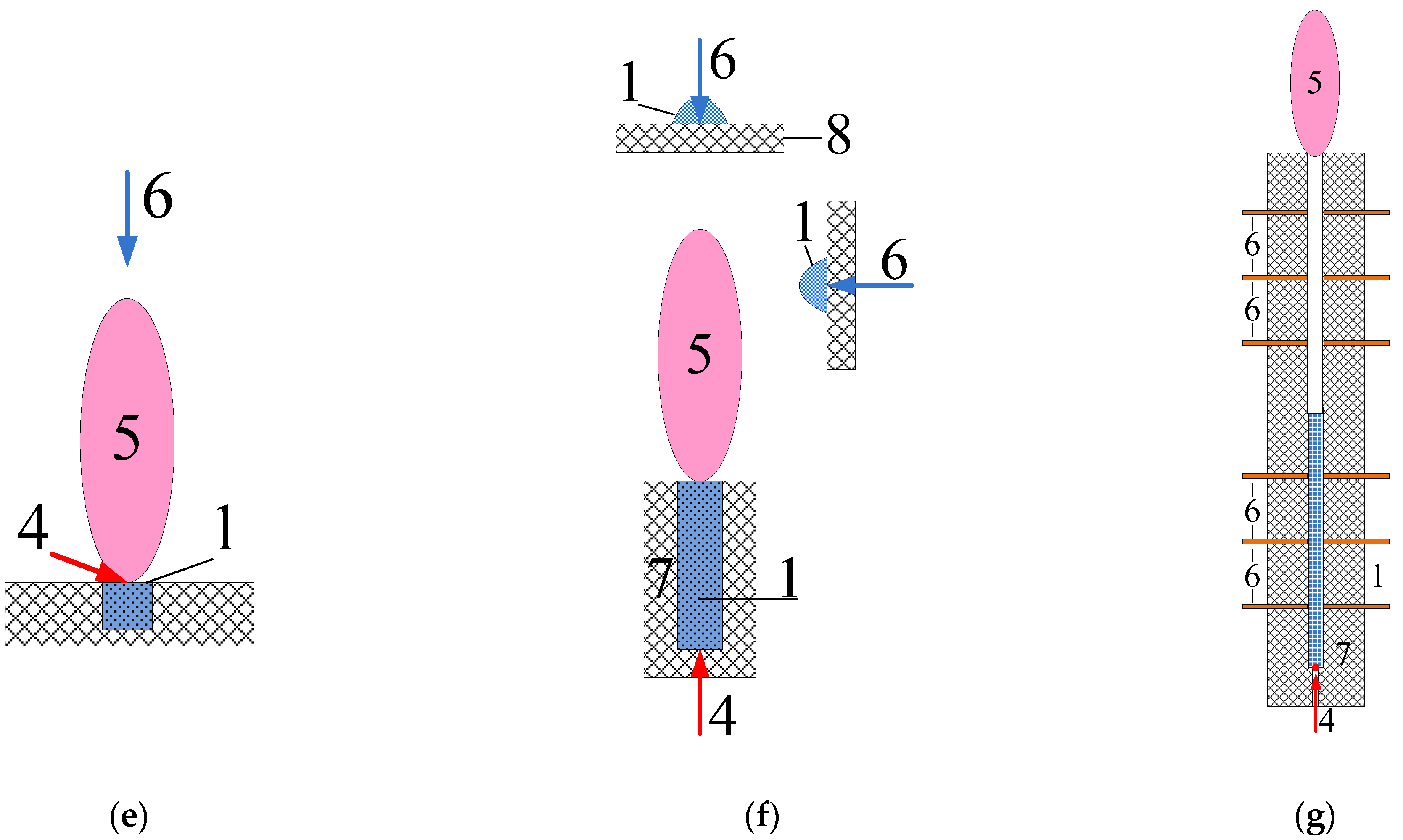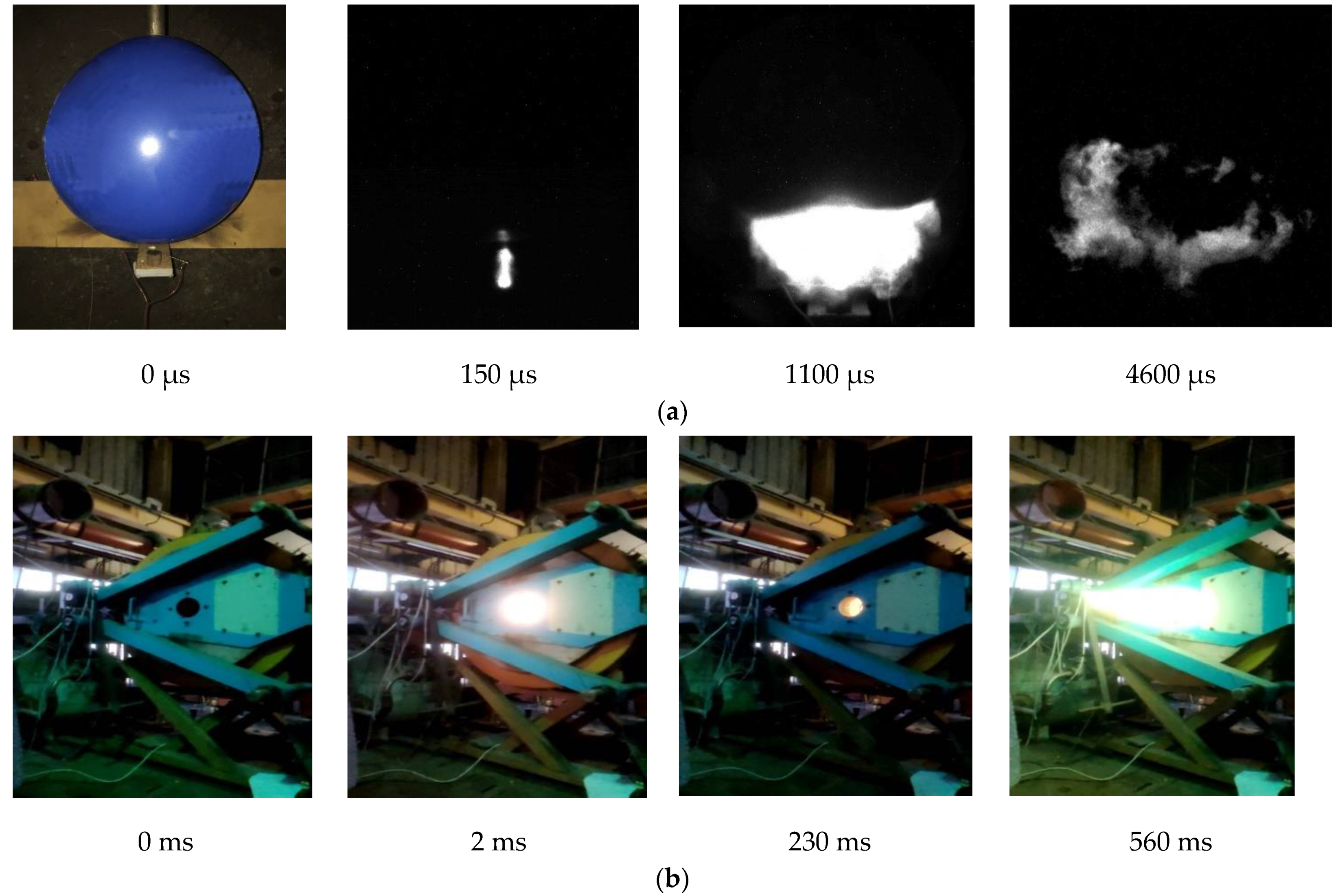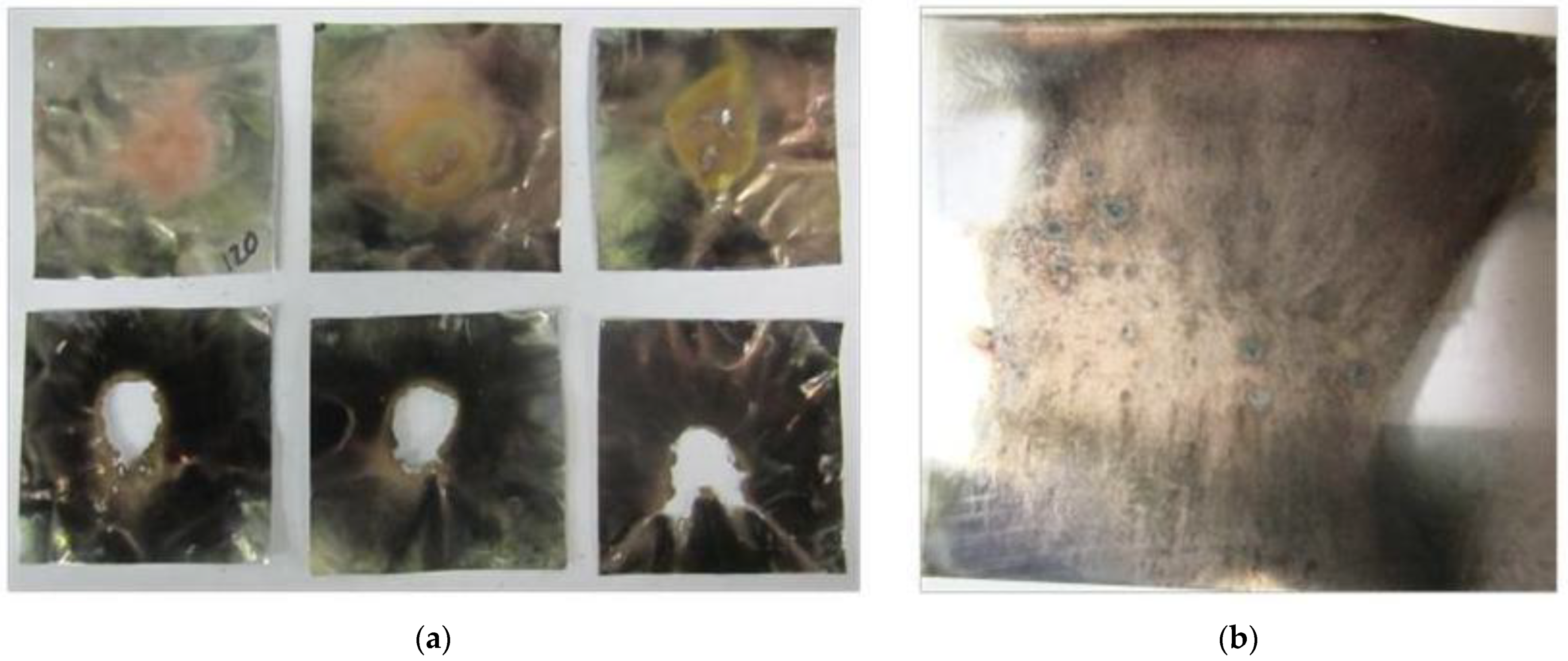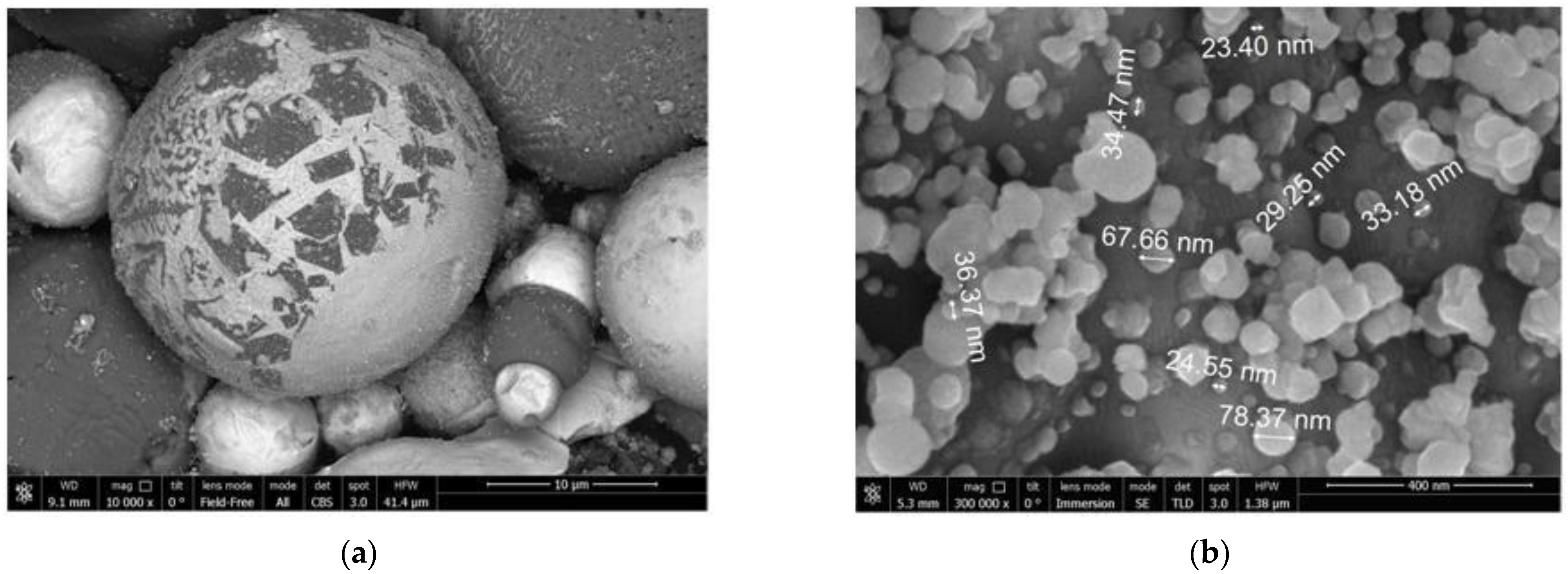Explosive Burning of a Mechanically Activated Al and CuO Thermite Mixture
Abstract
:1. Introduction
2. Experimental
2.1. Materials and Methods
2.2. Experimental Schemes
- Initiation of a concentrated (l ≈ d ≈ h, length, width, height) sample of a thermite mixture of bulk density on a plane, Figure 2a. The geometry of the sample was a conventional hemisphere with radius ≈ 3.5 mm;
- Ignition of five weighed portions (l ≈ d ≈ h) of thermite mixture, distributed on a plane along one line through air gaps, Figure 2b. The interval for placing samples was 23–25–50–53 mm. Ignition occurred at one end of the line of samples. Electrical contact sensors are placed under the mixture samples.
- Ignition of a linear sample (l ≥ d ≈ h) of a thermite mixture of bulk density on a plane, Figure 2c. With a sample length of 200 mm, initiation was carried out at its beginning. With a sample length of 400 mm, initiation was carried out in its middle. Electrical sensors were installed along the length of linear samples with an interval of 25–25–50–50 mm to one side from the point of initiation.
- Ignition of a linear sample (l ≥ d ≈ h) of a thermite mixture of bulk density in a shallow (d = h) groove, Figure 2d. The groove section was 3 × 3 mm. The ignition was carried out at the end of the groove.
- Ignition of a bulk density thermite mixture localized in a shallow cell (d = h), Figure 2e. Shallow cell diameter 4 mm, depth 2 mm. The mixture was ignited on a free surface at spark energies of 10 ± 1, 25 ± 2 and 100 ± 6 mJ.
- Ignition of a bulk density thermite mixture in a short channel (l = 2.5 d), Figure 2f. Channel length 10 mm, diameter 4 mm. The ignition was carried out at the bottom of the groove. Thin flat targets were placed opposite the channel at a distance of 30–200 mm. The targets retained traces of the transverse structure of the combustion product flow. Either 0.15 mm thick aluminium foils or 0.3 mm thick transparent polycarbonate films were used as targets. A thin layer of thermite mixture was applied to the reverse side of the polycarbonate targets. The same polycarbonate targets were installed to the side of the trajectory of the flow of combustion products.
- Ignition of a bulk density thermite mixture in a long channel (l ≈ 18 d), Figure 2g. Channel diameter was 4.5 mm. The total length of the channel was 160 mm, the length of the channel filled with the mixture was 80 mm. The ignition was carried out at the bottom of the groove.
3. Results
4. Discussion
5. Conclusions
- Evidence was obtained for the heterogeneity of the flow of the reacting components of the mixture surrounded by a cloud of emitted plasma of the reaction products;
- The dominant role of scattering clusters carrying the centres of a chemical reaction in the initiation of a cold mixture through an air gap of up to 150 mm had been established;
- A quantitative characteristic of the combustion dynamics of the studied mixtures of aluminium with copper oxide was obtained;
- An increase in the mass of local samples led to an increase in the expansion rate of the chemical energy release area. The limitation of the expansion of combustion products by the side walls within the height of the mixture track also led to an increase in the combustion rate;
- The combustion of a thermite mixture of Al and CuO is promising for use in single-shot systems for gas mixtures ignition.
Supplementary Materials
Author Contributions
Funding
Institutional Review Board Statement
Informed Consent Statement
Data Availability Statement
Acknowledgments
Conflicts of Interest
References
- Goldschmidt, H.; Vautin, C. Aluminium as a Heating and Reducing Agent. J. Soc. Chem. Ind. 1898, 6, 543–545. [Google Scholar]
- Shidlovskiy, A.A. Principles of Pyrotechnics; American Fireworks News: Dingmans Ferry, PA, USA, 1997; 270p. [Google Scholar]
- Son, S.F.; Busse, J.R.; Asay, B.W.; Peterson, P.D.; Mang, J.T.; Bockmon, B.; Pantoya, M.L. Propagation Studies of Metastable Intermolecular Composites (MIC). In Proceedings of the Twenty-Ninth International Pyrotechnics Seminar, Westminster, CO, USA, 14–19 July 2002; Schelling, F.J., Ed.; Los Alamos National Laboratory: Westminster, CO, USA, 2002; pp. 203–212. [Google Scholar]
- Zarko, V.E.; Gromov, A. (Eds.) Energetic Nanomaterials. Synthesis, Characterization, and Application; Elsevier: Amsterdam, The Netherlands, 2016; 392p. [Google Scholar]
- Bhattacharya, S.; Agarwal, A.K.; Rajagopalan, T.; Patel, V.K. (Eds.) Nano-Energetic Materials, Energy, Environment and Sustainability; Springer: Singapore, 2019; 290p. [Google Scholar]
- Yan, Q.-L.; He, G.-Q.; Liu, P.-J.; Gozin, M. (Eds.) Nanomaterials in Rocket Propulsion Systems; Elsevier: Amsterdam, The Netherlands, 2019; 592p. [Google Scholar]
- Sundaram, D.; Yang, V.; Yetter, R. Metal-Based Nanoenergetic Materials: Synthesis, Properties, and Applications. Prog. Energy Combust. Sci. 2017, 61, 293–365. [Google Scholar] [CrossRef]
- Kabra, S.; Gharde, S.; Gore, P.; Jain, S.; Khire, V.H.; Kandasubramanian, B. Recent Trends in Nanothermites: Fabrication, Characteristics and Applications. Nano Express 2020, 1, 032001. [Google Scholar] [CrossRef]
- Trache, D.; DeLuca, L.T. Nanoenergetic Materials: Preparation, Properties, and Applications. Nanomaterials 2020, 10, 2347. [Google Scholar] [CrossRef] [PubMed]
- Yetter, R.A. Progress towards Nanoengineered Energetic Materials. Proc. Comb. Inst. 2021, 38, 57–81. [Google Scholar] [CrossRef]
- Weiser, V.; Roth, E.; Kelzenberg, S.; Becker, W.; Sachsenheimer, K. Experimental and Theoretical Comparison of a Systematic Variety of Thermite Compositions. In Proceedings of the 46th International Annual Conference of the Fraunhofer ICT: Energetic Materials. Performance, Safety and System Applications, Karlsruhe, Germany, 23–26 June 2015; Fraunhofer Institute fur Chemische Technologie: Pfinztal, Germany, 2015; p. 24. [Google Scholar]
- Marshall, V.C. Major Chemical Hazards; Ellis Horwood Limited: Chichester, UK; Halsted Press: New York, NY, USA, 1987; 587p. [Google Scholar]
- Greenberg, H.R.; Cramer, J.J. (Eds.) Risk Assessment and Risk Management for the Chemical Process Industry; Van Nostrand Reinhold Company: New York, NY, USA, 1991; 315p. [Google Scholar]
- Penenko, V.V.; Aloyan, A.E. Models and Methods for Environmental Protection Problems; Nauka: Novosibirsk, Russia, 1985; 254p. [Google Scholar]
- Korf, E.I.; Katz, M.I. Safety and Fire Protection Technology in the Chemical Industry; Higher school: Moscow, Russia, 1961; p. 94. [Google Scholar]
- Lyapkov, A.A.; Ionova, U.I. Environmental Engineering, 2nd ed.; Publishing House of the Tomsk Polytechnic University: Tomsk, Russia, 2008; 317p. [Google Scholar]
- Banerjee, K.; Cheremisinoff, N.P.; Cheremisinoff, P.N. Flare Gas Systems Pocket Handbook; Gulf Publishing Company: Houston, TX, USA, 1985. [Google Scholar]
- Smith, J.D.; Al-Hameedi, H.A.; Jackson, R.; Suo-Antilla, A. Testing and Prediction of Flare Emissions Created during Transient Flare Ignition. Int. J. Petrochem. Res. 2018, 2, 175–181. [Google Scholar] [CrossRef]
- Pang, W.; Fan, X.; Wang, K.; Chao, Y.; Xu, H.; Qin, Z.; Zhao, F. Al-Based Nano-Sized Composite Energetic Materials (Nano-CEMs): Preparation, Characterization, and Performance. Nanomaterials 2020, 10, 1039. [Google Scholar] [CrossRef] [PubMed]
- Dreizin, E.L.; Schoenitz, M. Mechanochemically Prepared Reactive and Energetic Materials: A Review. J. Mater. Sci. 2017, 52, 11789–11809. [Google Scholar] [CrossRef]
- Woodruff, C.; Wainwright, E.R.; Bhattacharia, S.; Lakshman, S.V.; Weihs, T.P.; Pantoya, M.L. Thermite Reactivity with Ball Milled Aluminum-Zirconium Fuel Particles. Combust. Flame 2020, 211, 195–201. [Google Scholar] [CrossRef]
- Chen, J.; Guo, T.; Ding, W.; Song, J.; Yao, M.; Bei, F.; Li, S. Effect of CuO on the Thermal Kinetics and Combustion Properties of Al/MoO3 Thermite Prepared by Ball Milling. Ceram. Int. 2021, 47, 16500–16510. [Google Scholar] [CrossRef]
- Monk, I.; Schoenitz, M.; Jacob, R.J.; Dreizin, E.L.; Zachariah, M.R. Combustion Characteristics of Stoichiometric Al-CuO Nanocomposite Thermites Prepared by Different Methods. Combust. Sci. Technol. 2017, 189, 555–574. [Google Scholar] [CrossRef]
- Tichtchenko, E.; Estève, A.; Rossi, C. Modeling the Self-Propagation Reaction in Heterogeneous and Dense Media: Application to Al/CuO Thermite. Combust. Flame 2021, 228, 173–183. [Google Scholar] [CrossRef]
- Shi, K.; Guo, X.; Chen, L.; Huang, S.; Zhao, L.; Ji, J.; Zhou, X. Alcohol-Thermal Synthesis of Approximately Core-shell Structured Al@CuO Nanothermite with Improved Heat-Release and Combustion Characteristics. Combust. Flame 2021, 228, 331–339. [Google Scholar] [CrossRef]
- Mursalat, M.; Schoenitz, M.; Dreizin, E.L. Effect of Premilling Al and CuO in Acetonitrile on Properties of Al·CuO Thermites Prepared by Arrested Reactive Milling. Combust. Flame 2020, 214, 57–64. [Google Scholar] [CrossRef]
- Ananev, S.Y.; Grishin, L.I.; Yankovsky, B.D.; Kirilenko, V.G.; Dolgoborodov, A.Y. Effect of Mechanical Activation on Combustion Characteristics of Al–CuO Powder Mixture. J. Phys. Conf. Ser. 2021, 1787, 012016. [Google Scholar] [CrossRef]
- Streletskii, A.N.; Kolbanev, I.V.; Vorobieva, G.A.; Dolgoborodov, A.Y.; Kirilenko, V.G.; Yankovskii, B.D. Kinetics of Mechanical Activation of Al/CuO Thermite. J. Mater. Sci. 2018, 19, 13550–13559. [Google Scholar] [CrossRef]
- Zel′dovich, Y.B.; Raiser, Y.P. Physics of Shock Waves and High-Temperature Hydrodynamic Phenomena; Nauka-Fizmatlit: Moscow, Russia, 1966; p. 686. [Google Scholar]
- Lawton, J.; Weinberg, F.J. Electrical Aspects of Combustion; Clarendon Press: Oxford, UK, 1969; p. 419. [Google Scholar]
- Kondratyev, V.N.; Nikitin, E.E. Chemical Processes in Gases; Nauka: Moscow, Russia, 1981; p. 264. [Google Scholar]
- Bratton, K.R.; Woodruffa, C.; Campbell, L.L.; Heaps, R.J.; Pantoya, M.L. A Closer Look at Determining Burning Rates with Imaging Diagnostics. Opt. Lasers Eng. 2020, 124, 105841. [Google Scholar] [CrossRef]







| No. | Experimental Set-up No. (Figure 2) | M (g) | U0 (m/s) | Luminescence Volume V at Time tph after Ignition [cm3 (ms)] | Rate of the Glowing Volume Formation V/tm (cm3/μs) |
|---|---|---|---|---|---|
| 1 | 2a | 0.06 | 118 | 134 (2.2) | 0.05 |
| 0.25 | 101 | 450 (1.5) | 0.3 | ||
| 0.75 | 109 | 780 (1.5) | 0.52 | ||
| 1.5 | 129 | 1280 (1.2) | 0.89 | ||
| 2 | 2b | 0.06 × 5 | 55 | 107 (2.1) | 0.34 |
| 3 | 2c | 8 (0.4 g/cm) | 65 | 7226 (2.4) | 3 |
| 8.5 (0.21 g/cm) | 76 | 2009 (2.5) | 0.8 | ||
| 4 | 2d | 3 (0.2 g/cm) | 52 | 785 (2.5) | 0.39 |
| 5 | 2e | 0.06 | 55 | 136 (2.5) | 0.054 |
| 78 | 107 (2.5) | 0.043 | |||
| 120 | 89 (2.5) | 0.036 | |||
| 6 | 2f | 0.3 | Photographic recording of the process was not made | ||
| 0.25 | 75–95 | 300 (2.5) | 0.12 | ||
| 0.2 | 84 | 226 (2.5) | 0.09 | ||
| 7 | 2g | 3.3 | 192 | 360 (3) | 0.12 |
Publisher’s Note: MDPI stays neutral with regard to jurisdictional claims in published maps and institutional affiliations. |
© 2022 by the authors. Licensee MDPI, Basel, Switzerland. This article is an open access article distributed under the terms and conditions of the Creative Commons Attribution (CC BY) license (https://creativecommons.org/licenses/by/4.0/).
Share and Cite
Dolgoborodov, A.; Yankovsky, B.; Ananev, S.; Valyano, G.; Vakorina, G. Explosive Burning of a Mechanically Activated Al and CuO Thermite Mixture. Energies 2022, 15, 489. https://doi.org/10.3390/en15020489
Dolgoborodov A, Yankovsky B, Ananev S, Valyano G, Vakorina G. Explosive Burning of a Mechanically Activated Al and CuO Thermite Mixture. Energies. 2022; 15(2):489. https://doi.org/10.3390/en15020489
Chicago/Turabian StyleDolgoborodov, Alexander, Boris Yankovsky, Sergey Ananev, George Valyano, and Galina Vakorina. 2022. "Explosive Burning of a Mechanically Activated Al and CuO Thermite Mixture" Energies 15, no. 2: 489. https://doi.org/10.3390/en15020489
APA StyleDolgoborodov, A., Yankovsky, B., Ananev, S., Valyano, G., & Vakorina, G. (2022). Explosive Burning of a Mechanically Activated Al and CuO Thermite Mixture. Energies, 15(2), 489. https://doi.org/10.3390/en15020489






